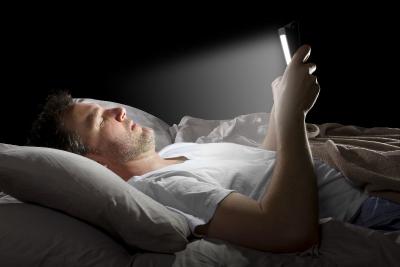Excessive exposure to blue light has been linked to many health issues - including cancer, diabetes, heart disease, obesity and insomnia. Children, especially, have delicate retinas that are highly susceptible to the dangers of blue light.

Researchers from Taiwan's National Tsing-Hua University, led by Prof. J.H. Jou, have been advocates of candle-light OLED lighting for a long time, as part of their fight against the hazards of LEDs and white light. In 2015, the researchers published a call out to consumers to be aware of the hazards of LEDs and to governments to enact new rules to enforce light-based products to show the light spectrum.
The problem, however, does not end with lighting. We all watch displays almost all day long - televisions, computer monitors, laptops and of course smartphones. Back in 2014, LG Display declared that LCD TVs emit 3.1X more blue light compared to OLED TVs, and in 2015 Samsung Display demonstrated a "healthier' Bio-Blue OLED display that emits only 6% blue light (compared to 32% in regular smartphone OLEDs and 66" in LCDs).
But what exactly is the risk with smartphone displays? We set out to find out and talked to NTHU's Prof. Jou. The research group at NTHU developed its own patented methodology to quantify the threat of light on melatonin generation at night - one of the major problems with blue light. These tests can be performed on any display - from TVs to smartphones.

According to Prof. Jou, basically there should be little difference between OLEDs and LCDs if they emit the same color temperature. However they recently performed a test to compared two smartphones - an iPhone 7 with an LCD display and the newest iPhone XS Max with its 6.5" AMOLED display.
The researchers compared two metrics. The first is Maximum Permissible Exposure, or MPE. This is a measure of time before the retina gets inflammated following an exposure to the screen. The tests are based on a light output of 100 lx. The MPE for the iPhone 7 is 288 seconds - while the MPE on the iPhone XS Max is 346 seconds - which means that the OLED is quite safer than the LCD.
The second metric is Melatonin Suppression Sensitivity - or MSS. This is a relative measurement, or a percentage that shows the suppression compared to a pure blue light. An MSS of 100% is similar to looking at a pure blue light. Here, again, the OLED performs better - the MSS for the iPhone 7 LCD is 24.6% while the MSS for the AMOLED iPhone XS Max is 20.1%.
Basically the test quantifies the fact that the color temperature of the OLED display is lower than the one for the LCD on the iPhone 7. The images themselves will look quite similar to the user, but the OLED emits less blue light.
This is an interesting result. It is likely that LCDs can be calibrated to a lower temperature as well - but it may also be that the nature of OLEDs allows it to show the same display quality at a lower, and safer, color temperatures. So now we have another reason to opt for OLED displays!
Comments
Thanks William. For an OLED display, I think a night-shift setting can be useful I believe.
You have not touched apron the issue of PWM in Amoleds, the safe for human % is 5-10%, while Amoleds, when brightness is less than 50%, emit over 140%(PWM). Which the eye doesn’t not see, but the brain registers.
I have seen a lot of screen protectors for phone and tablets that say they reduce or protect from blue light, is that a good solution for iPad users to use? Say iPad+(blue light protection) screen guard vs. OLED display, how does that compare? thanks
This is an interesting way to frame the OLED vs LCD discussion, and the specs seem to point to a certain “reality” that OLEDs are nicer to our eyes than LCDs. While that may objectively be the case, it is unfortunately not true in its current implementation, due to the widespread & frankly irresponsible & unethical use of PWM in dimming the displays below 100%. You will find pages & pages in the forums of scores of people complaining of headaches, eye pains, migraines etc. Because even when they are supposed to have reduced the brightness to protect their eyes or adjust to the ambient lighting, in actuality the eyes are still being blasted by full brightness OLED display at something like 800 nits. This is crazy. The brain gets fooled by the PWM but obviously the eyes, the receptors do not & suffer the horrendous effects. How is this even allowed to be done by the manufacturers?


Thanks so much for the great analysis! My right eye has been injured in the past and only hurts when I do not employ Nightshift on my iphone screen to remove the blue light. Can you please comment on how effective Nightshift would be on removing blue light from the Iphone XR which I'm considering buying? Thank you!